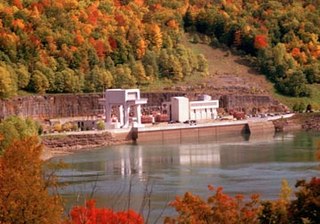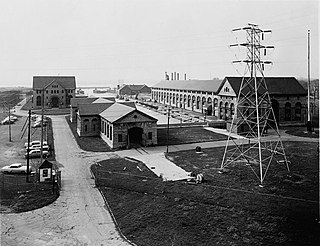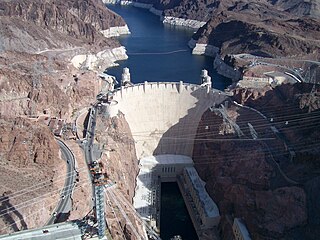
Hydroelectricity, or hydroelectric power, is electricity generated from hydropower. Hydropower supplies one sixth of the world's electricity, almost 4,500 TWh in 2020, which is more than all other renewable sources combined and also more than nuclear power. Hydropower can provide large amounts of low-carbon electricity on demand, making it a key element for creating secure and clean electricity supply systems. A hydroelectric power station that has a dam and reservoir is a flexible source, since the amount of electricity produced can be increased or decreased in seconds or minutes in response to varying electricity demand. Once a hydroelectric complex is constructed, it produces no direct waste, and almost always emits considerably less greenhouse gas than fossil fuel-powered energy plants. However, when constructed in lowland rainforest areas, where part of the forest is inundated, substantial amounts of greenhouse gases may be emitted.

An underground power station is a type of hydroelectric power station constructed by excavating the major components from rock, rather than the more common surface-based construction methods.
The New York Power Authority (NYPA), is the largest state public power utility in the United States providing some of the lowest-cost electricity in the nation, operating 16 generating facilities and more than 1,400 circuit-miles of transmission lines. Its main administrative offices are in White Plains, New York
The Shoalhaven Scheme is a dual-purpose water supply and Pumped-storage Hydroelectricity scheme located on the South Coast region of New South Wales, Australia.

The Robert-Bourassa generating station, formerly known as La Grande-2 (LG-2), is a hydroelectric power station on the La Grande River that is part of Hydro-Québec's James Bay Project in Canada. The station can generate 5,616 MW and its 16 units were gradually commissioned between 1979 and 1981. Annual generation is in the vicinity of 26500 GWh.

Sir Adam Beck Hydroelectric Generating Stations are two hydroelectric generating stations in Niagara Falls, Ontario, Canada. Sir Adam Beck Generating Station I, Sir Adam Beck Generating Station II and the Sir Adam Beck Pump Generating Station are all owned by Ontario Power Generation. Following the development of several smaller generating stations around Niagara Falls in the late 19th and early 20th centuries, the Province of Ontario authorized the construction of the first major publicly owned generating station in the province. At the time it was built, it was the largest hydroelectric generating station in the world.

The Rubicon Hydroelectric Scheme is a small run-of-the-river hydroelectric scheme located on the Rubicon and Royston Rivers, north east of Melbourne, 40 km (25 mi) south-west of Alexandra, Victoria, Australia. The scheme commenced in 1922, and was the first state-owned hydroelectric scheme to generate electricity in mainland Australia, and among the first in the world to be remotely controlled. For the first ten years of its operation it supplied on average 16.9% of electricity generated by the State Electricity Commission of Victoria. It is now owned and operated by AGL Energy and contributes approximately 0.02% of Victoria's energy supply.

The Blenheim–Gilboa Pumped Storage Power Station is a pumped-storage hydroelectricity plant in the Catskill Mountains of New York State. The plant is part of the New York Power Authority, and can generate over 1,100 megawatts (1,500,000 hp) of electricity, all of which is sent to New York City. It is used daily to cover peak demand. There are two reservoirs that are involved in the project, both with a capacity of 5 billion US gallons (19,000,000 m3); one at the foot of Brown Mountain in the Schoharie Valley, and another one at the top of the mountain. The power station has an accumulated capacity of about 12,000 megawatt-hours (43,000 GJ) after storing up to 17,000 megawatt-hours (61,000 GJ).

Run-of-river hydroelectricity (ROR) or run-of-the-river hydroelectricity is a type of hydroelectric generation plant whereby little or no water storage is provided. Run-of-the-river power plants may have no water storage at all or a limited amount of storage, in which case the storage reservoir is referred to as pondage. A plant without pondage is subject to seasonal river flows, so the plant will operate as an intermittent energy source. Conventional hydro uses reservoirs, which regulate water for flood control, dispatchable electrical power, and the provision of fresh water for agriculture.

Adams Power Plant Transformer House in Niagara Falls, New York is a National Historic Landmarked building constructed in 1895. It is the only remaining structure that was part of the historic Edward Dean Adams Power Plant, the first large-scale, alternating current electric generating plant in the world, built in 1895. The building's eponym was Edward Dean Adams, a businessman and entrepreneur in the electrical field.

Hydroelectricity is, as of 2019, the second-largest renewable source of energy in both generation and nominal capacity in the United States. In 2021, hydroelectric power produced 31.5% of the total renewable electricity, and 6.3% of the total U.S. electricity.

The Siah Bisheh Pumped Storage Power Plant, also spelled Siyāhbisheh and Siah Bishe, is located in the Alborz Mountain range near the village of Siah Bisheh and 48 km (30 mi) south of Chalus in Mazandaran Province, Iran. The power plant uses the pumped-storage hydroelectric method to generate electricity during periods of high energy demand, making it a peaking power plant, intended to fulfill peak electricity demand in Tehran 60 km (37 mi) to the south. When complete it will have an installed generating capacity of 1,040 megawatts (1,390,000 hp) and a pumping capacity of 940 megawatts (1,260,000 hp). Planning for the project began in the 1970s and construction began in 1985. It was delayed from 1992 until 2001 and the first generator went online in May 2013. The remaining generators were commissioned by 1 September 2015. The power plant is the first pumped-storage type in Iran and will also use the country's first concrete-face rock-fill dam – two of them.
Niagara Falls Hydraulic Power & Manufacturing Company was an American company, based in Niagara Falls, New York that was the first company to generate hydroelectric power from Niagara Falls in 1882. The company built upon several predecessor companies efforts to construct a canal used for hydraulic mill power. In 1918, the company merged with Niagara Falls Power Company, which later became Niagara Mohawk and in 2002 was acquired by National Grid plc.
The Hohhot Pumped Storage Power Station, also known by Huhehaote, is located 20 kilometres (12 mi) north of Hohhot in Inner Mongolia, China. It uses the pumped-storage hydroelectric method to generate electricity. The plant has an installed capacity of 1,224 megawatts (1,641,000 hp). Construction began in 2005 and the first generator was commissioned on 20 November 2014. The second generator was commissioned on 26 December 2014 and the final two were commissioned in June 2015.

The Rocky Mountain Hydroelectric Plant is a pumped-storage power plant located 10 miles (16 km) northwest of Rome in the U.S. state of Georgia. It is named after Rock Mountain on top of which the plant's upper reservoir is located. Construction on the plant began in 1977 and it was commissioned in 1995. After upgrades were completed in 2011, the plant has an installed capacity of 1,095 megawatts (1,468,000 hp). It is owned by both Oglethorpe Power and Georgia Power which have 75 percent and 25 percent stakes, respectively.

The Vianden Pumped Storage Plant is located just north of Vianden in Diekirch District, Luxembourg. The power plant uses the pumped-storage hydroelectric method to generate electricity and serves as a peaking power plant. Its lower reservoir is located on the Our River, bordering Germany, and the upper is elevated above on the nearby Saint Nicholas Mountain. Construction on the plant began in 1959 and the first pump-generators were commissioned in 1962. A tenth pump-generator was installed in 1976 bringing the plant's installed generating capacity to 1,096 megawatts (1,470,000 hp). The plant generates an average of 1,650 gigawatt-hours (5,900 TJ) annually but of course consumes even more. Generally the efficiency of this energy storage method is around 70–80%. The plant is owned by Société électrique de l'Our and RWE. Construction on an eleventh pump-generator began in 2010 and it is expected to be commissioned in 2013, which will bring the plant's installed capacity to 1,296 megawatts (1,738,000 hp).

The Kyiv Pumped-Storage Power Plant is a pumped-storage power station on the west bank of the Kyiv Reservoir in Vyshhorod, Ukraine. The Kyiv Reservoir serves as the lower reservoir and the upper reservoir is located 70 m (230 ft) above the lower. Water sent from the upper reservoir generates electricity with three 33.3 megawatts (44,700 hp) conventional hydroelectric generators and three 45 megawatts (60,000 hp) reversible pump generators. During periods of low demand, such as nighttime, the pump generators push water from the lower reservoir to the upper for use during peak hours. The first generator was commissioned in 1970, and the last in 1972.

The Schoellkopf Power Station was built on land owned by Jacob F. Schoellkopf above the Niagara Gorge near the American Falls, 1,600 feet (490 m) downriver from Rainbow Bridge. Understanding the growing need for electricity and the role of harnessing the Falls, Schoellkopf purchased the land for the hydraulic canal on May 1, 1877 for $71,000. After Schoellkopf Sr.'s death in 1903, his sons took over the operation of the power business. In 1918, Schoellkopf's Niagara Falls Hydraulic Power and Manufacturing Company merged with the Niagara Falls Power Company, which was owned by Edward Dean Adams. Much of the site is, as of 2014, occupied by the Maid of the Mist tour boat company as a maintenance area and off-season boat storage yard. The power station remains form a part of a fully accessible tourist attraction associated with Niagara Falls State Park and is connected with its Niagara Gorge hiking trail system.

The Snoqualmie Falls Hydroelectric Plant is located just north of Snoqualmie in King County, Washington state, US. It is situated about 22 mi (35 km) east of Seattle. Located just below the Snoqualmie Falls, the power plant consists of two power houses, Plant 1 and Plant 2. Plant 1 was completed in 1899 and is located underground. It is the first completely underground hydroelectric power plant ever built in the world. Plant 2 was built in 1910 and is located along the right bank of the Snoqualmie River. Both plants receive water from a small reservoir created by a weir atop the falls. Plant 1 has an installed capacity of 13.7 MW and Plant 2 a capacity of 40.2 MW for a total installed capacity of 53.9 MW, enough to power 40,000 homes.
















